The views expressed in our content reflect individual perspectives and do not represent the authoritative views of the Baha'i Faith.
“My life’s goal as an artist is to unlock the secrets to the oldest stories and create new ones,” wrote Oletha DeVane, a Baha’i multidisciplinary artist.
RELATED: How One Playwright Is Honoring Black Girlhood Stories
Oletha DeVane, the former director of Tuttle Art Gallery, was one of the first African American artists invited to the United Arab Emirates as an Artist-in-Residence. Her work has been featured in numerous museums and galleries and collected by the Hilton Hotel in Baltimore, Sheppard and Enoch Pratt Hospital, the Baltimore Museum of Art, the Johns Hopkins University museums, the James E. Lewis Museum of Art, and The Harbor Bank of Maryland.
RELATED: Artist Masud Olufani Honors the First African American Baha’i
As a big fan of Oletha’s art, I was excited to learn more about the spiritual and historical inspiration behind Oletha’s artwork that honors our enslaved, African, and female ancestors.
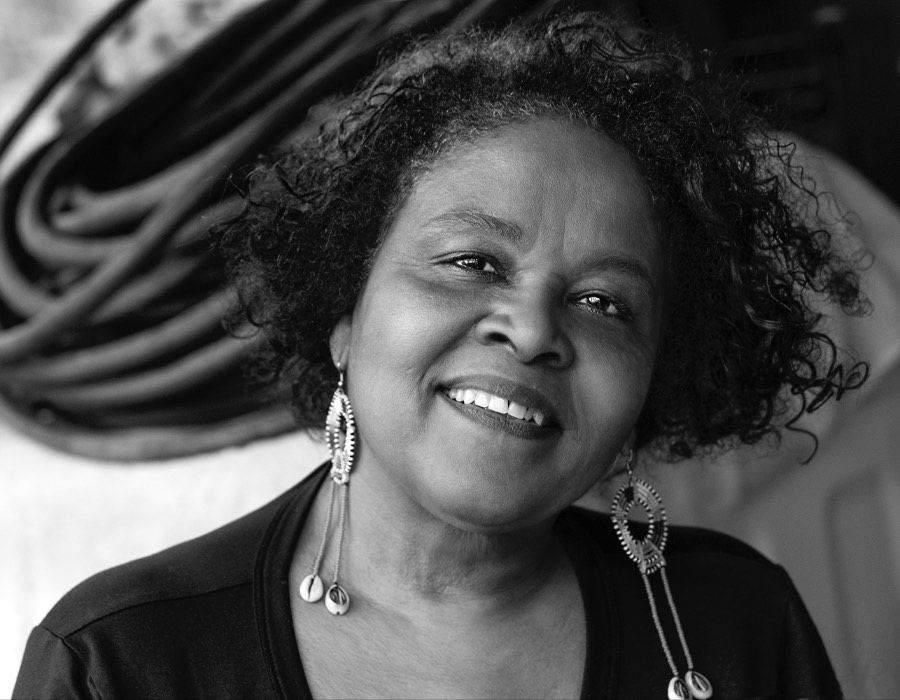
Radiance Talley: Hi, Oletha! Thank you for taking the time to answer my questions. Can you share how the Baha’i writings inspire you as an artist?
Oletha DeVane: The writings revealed the highest level of social consciousness for me when [I was] growing up in the ‘60s. I had learned about the [Baha’i] Faith from our neighbors, Albert and Ruth James. I wanted to become a Baha’i at 13 years old, the year the four Black girls were killed at the 16th Street Baptist Church. The country was steeped in hatred, and the meetings in the James’s home were a revelation about oneness and equality that was spiritually and conceptually important for me at the time. I felt safe in a community of people that embraced me as a child. The first two [quotes by Baha’u’llah, the prophet and founder of the Baha’i Faith, in The] Hidden Words are my favorite:
O SON OF SPIRIT!
My first counsel is this: Possess a pure, kindly and radiant heart, that thine may be a sovereignty ancient, imperishable and everlasting.O SON OF SPIRIT!
The best beloved of all things in My sight is Justice; turn not away therefrom if thou desirest Me, and neglect it not that I may confide in thee. By its aid thou shalt see with thine own eyes and not through the eyes of others, and shalt know of thine own knowledge and not through the knowledge of thy neighbor. Ponder this in thy heart; how it behooveth thee to be. Verily justice is My gift to thee and the sign of My loving-kindness. Set it then before thine eyes.
All [The Hidden Words] pointed to what was needed to make social change. The writings are so metaphorically and symbolically poetic with references to light, water, nature, and the micro/macro connection to humanity’s life and the spirit.
Radiance: Can you tell us about your journey as a multidisciplinary artist and how it led you to your current focus on unlocking the secrets of old stories while creating new ones?
Oletha: The journey doesn’t stop. I have many questions and curiosities about other cultures, our society, [our] people, our future, and our practices. The story of humankind is an ancient one, with much of it forgotten or hidden. How can we understand or define what we cannot know except through our five senses and, ultimately, [through] conscious effort to know ourselves [and] gain knowledge? Imagine how we might define what’s unknown. It’s the stories we tell ourselves.
Abdu’l-Baha [one of the central figures of the Baha’i Faith] wrote:
EXISTENCE is of two kinds: one is the existence of God which is beyond the comprehension of man. He, the invisible, the lofty and the incomprehensible, is preceded by no cause but rather is the Originator of the cause of causes. He, the Ancient, hath had no beginning and is the all-independent. The second kind of existence is the human existence. It is a common existence, comprehensible to the human mind, is not ancient, is dependent and hath a cause to it. The mortal substance does not become eternal and vice versa; the human kind does not become a Creator and vice versa. The transformation of the innate substance is impossible.
In the world of existence—that which is comprehensible—there are stages of mortality: the first stage is the mineral world, next is the vegetable world. In the latter world the mineral doth exist but with a distinctive feature which is the vegetable characteristic. Likewise in the animal world, the mineral and vegetable characteristics are present and in addition the characteristics of the animal world are to be found, which are the faculties of hearing and of sight. In the human world the characteristics of the mineral, vegetable and animal worlds are found and in addition that of the human kind, namely the intellectual characteristic, which discovereth the realities of things and comprehendeth universal principles.”
I believe our responsibility is to encompass and understand our human stories that awaken us to material and spiritual progress. It’s the ancient stories of falls and rises, of war and peace, to grace and love.
Radiance: Can you explain how your art explores diverse social identities and cultural interpretations? How do you integrate these themes into your artistic practice?
Oletha: As a woman of African descent, I look back to my ancestors, the promises of all religions, and the origin of the 19th-century term “race.” Baha’u’llah’s ultimate promise [was] confirmed in His own words:
The Ancient Beauty hath consented to be bound with chains that mankind may be released from its bondage, and hath accepted to be made a prisoner within this most mighty Stronghold that the whole world may attain unto true liberty.
As a visual artist, I use multiple media (painting, collage, video, public art), which allow me to examine my place in the world by trying to make sense of how we got here at this moment in history. Our collective ignorance is what stagnates societies, and I’m trying to do work that integrates intergenerational stories and histories that shape us. For those ancestors who survived the Middle Passage and enslavement, [those] stories are as relevant as the Holocaust survivors and those who have faced genocides.
Radiance: Absolutely! My favorite piece of yours is the “Memorial to Those Enslaved and Freed” that you designed for the McDonogh School in Owings Mills, Maryland. Can you share the inspiration behind the memorial?
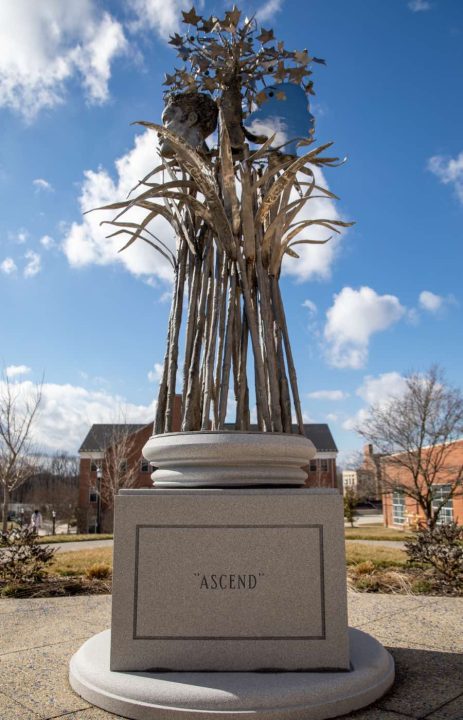
Oletha: The memorial has always been about recognizing and honoring those Black men, women, and children who, through their forced labor, made John McDonogh a wealthy man. It is about the aspiration and the resilience of a people who served in a capacity that made them invisible. Freedom was always the aspiration; they sought their freedom through any means necessary — you worked yourself to death to get free through manumission, or you ran away. From my lens, I am looking at how people were treated, what allowed them to survive, [and] what was the dignity in their lives?
Radiance: What are your favorite pieces that you’ve created to honor our ancestors?
Oletha: That’s a difficult question. However, to name a few: the print series of Harriet Tubman, the “Spirit Sculptures,” which are meant to harness blessings, and most recently, the “Universal N’kisi Woman.”
RELATED: 3 Lessons We Can Learn From My Relative Harriet Tubman
Radiance: We’d love to learn more about them! Can you walk us through your creative process for these pieces and describe the symbolism that you used?
Oletha: Harriet Tubman is symbolized in my work as the oracle: intelligent, courageous, and a fearless fighter for freedom. Tubman is featured in a series of solar etchings from (2017-19), and I adapted a previously unknown photograph of her (ca.1822-1913) and used it as the basis for the narrative prints. Some of them include the seedpods of the sweet gum tree, which littered the forest floor when she escaped with [her] family from Maryland’s Eastern Shore plantation. The seedpods represent the obstacle to freedom that those enslaved had to walk across barefoot.
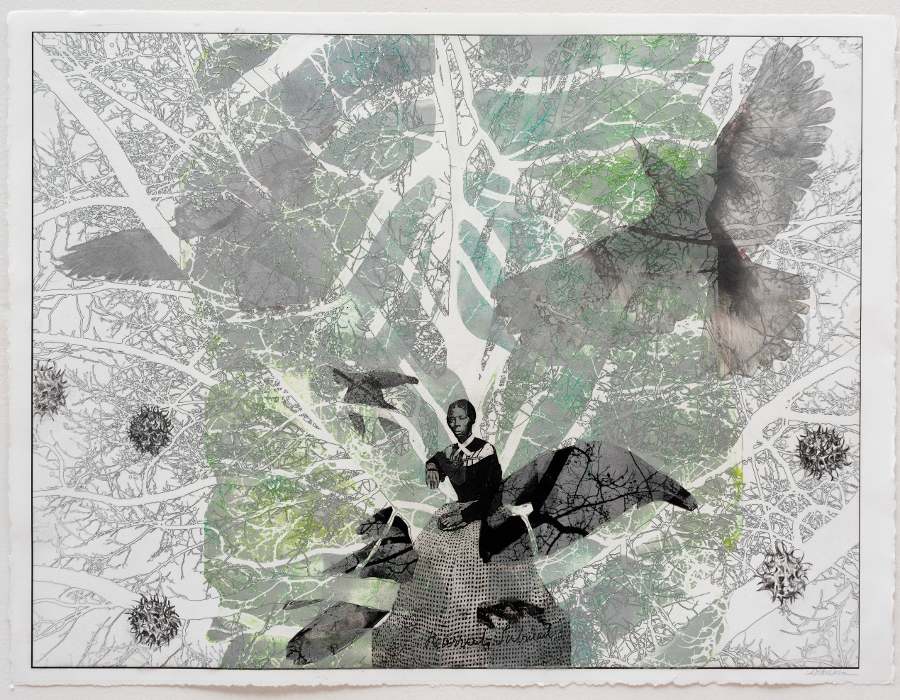
There are many “Spirit Sculptures,” but the one acquired by the Baltimore Museum of Art has the most significance to me — “Saint for My City” (2010). It is an avatar disguised as an astral-Black holy figure. The pedestal is embellished with the names of African diasporic deities (Isis, Ogun, Horus, Dumballa, etc). It is a memorial to people killed at the time, represented by bullet casing. The Black saint with outstretched arms channels the spirit of solace to Baltimore and the many Black people undergoing oppression through gun violence.

“Universal N’kisi Woman” (2021-22) is informed by an evolving worldview of Africa’s influence in the arts. It represents the retention of African belief systems, which are indigenous to the Congo. The N’kisi is a sacred form used in communities to settle disputes [and] provide counseling and advice. The nkisi, or minkisi, is a figure whose relationship to the community is to guide, protect, and dispense healing or justice. I chose to make a female N’kisi for the community to interact with by hammering a bead while engaged in silent prayers, concerns, or healing messages.
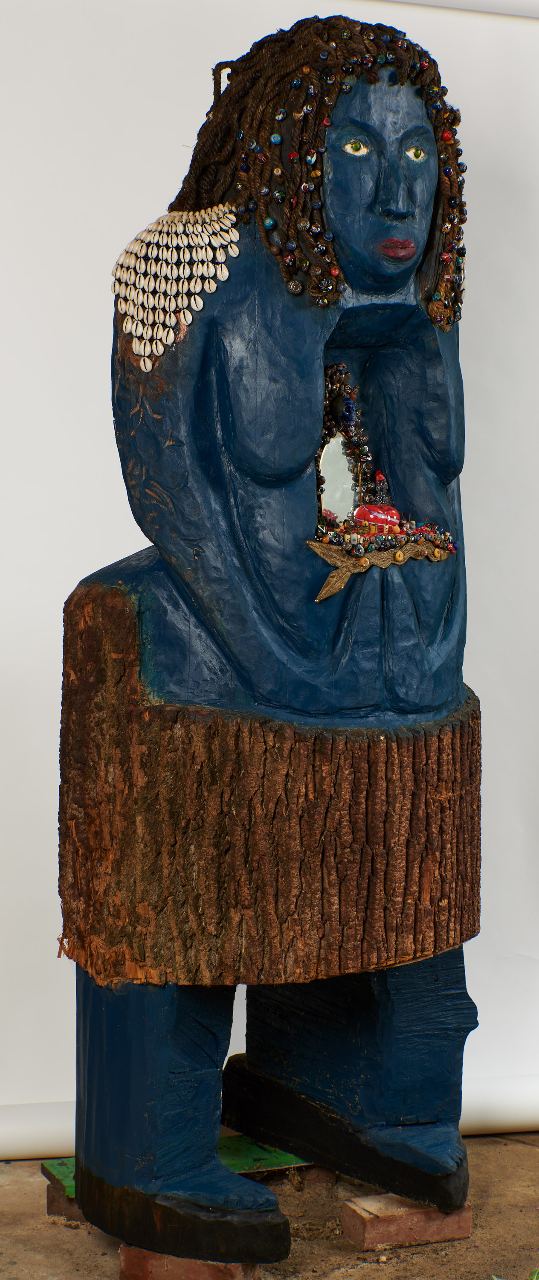
Radiance: What inspired these particular works, and what significance do they hold for you personally or artistically?
Oletha: Religious practices of freed [enslaved people] at the turn of the 19th century attempted to maintain their cultural origin, which today has informed Pan-African identity. Colonization destroyed the agency of African beliefs in the Americas, and the spiritual practices of syncretism retained the cultural Indigenous spirit. It’s what keeps me interested in origin stories, specifically as a Black artist and a Baha’i.
Radiance: Since March is Women’s History Month, can you explain how your art commemorates and celebrates the vital role of women in our national and global history?
Oletha: Most of my work reflects issues women face from explicit treatment of inequality, sexual exploitation, imprisonment, and endurance. [For example], the biblical story of Hagar metaphorically speaks of the struggle and strength of generations of women who endured injustice. It’s a story that resonated with generations of Black women who suffered injustice, and it’s a story that was told in Black churches across the country about the African woman in the household of [the] prophet Abraham. It prompted me to create the piece entitled “Hagar’s Dress in Her Exile,” made from chains and burlap (2013).
Radiance: In what ways do you see art as a tool for social change and community engagement, particularly concerning the honoring and preservation of diverse ancestries and histories?
Oletha: The Baha’i writings elevate the arts to do just that. Historically, if we look through the ages, art has been a considerable means of communication with the earliest of drawings and sounds. As sentient beings on a spectrum, we want others to experience what we see, feel, and think. Our inherent expressive ability is specifically geared to how we perceive our world and the changes we can make. Think about the art movements over the last 300 years, from the Renaissance to the Bauhaus to African Art to Abstract Expressionists, and so on. These movements all had a major impact on the cultures. Ideas and actions creatively materialize in a society based on its overarching philosophy, and some thoughts are better than others to manifest social change.
One aspect of the arts is visual, but there is also the written and spoken word, sound, and movement (music and dance), all of which can take on multiple forms and combinations. When we raise the question, can art be a tool for social change? My answer is, yes, it can, but what new ways will we use to connect communities and vigorously educate [people] to understand the historical importance of art to society?
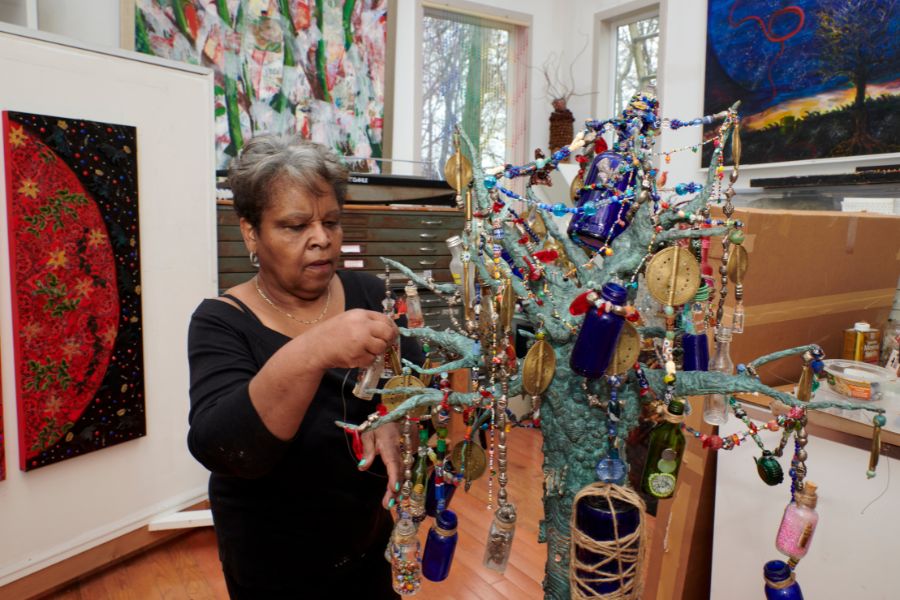
Radiance: Thank you, Oletha, for describing your beautiful artwork and sharing the historical and spiritual inspiration behind your pieces that honor our ancestors. Baha’u’llah wrote that “when it [the Sun of Truth] manifesteth itself in the mirrors of the hearts of craftsmen, it unfoldeth new and unique arts, and when reflected in the hearts of those that apprehend the truth it revealeth wondrous tokens of true knowledge and discloseth the verities of God’s utterance.” I can certainly see this light and spirit reflected in your craft.
You can view Oletha DeVane’s catalog, “Oletha DeVane: Spectrum of Light and Spirit,” at https://cadvc.umbc.edu/wp-content/uploads/sites/247/2024/01/Oletha-DeVane-Spectrum-of-light-and-spirit-catalog.pdf. To order, click here: https://www.artbook.com/9780960088546.html.

















Comments
Sign in or create an account
Continue with Facebookor